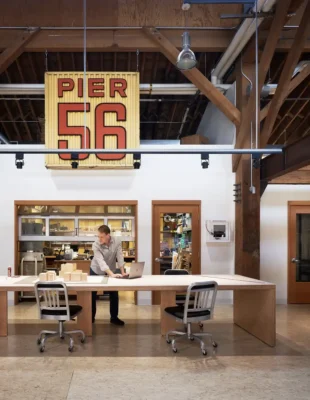
A 120-year-old waterfront landmark in Seattle has been reimagined into a highly adaptive workplace that blends health, sustainability, and cultural storytelling. Designed by Mithun, the 14,000-square-foot Pier 56 office space sits above Elliott Bay and serves as both a working studio and a model for future-focused sustainable architecture.

The renovated office is rooted in its maritime past while embracing a fully modern, wellness-oriented approach. Daylight, cross-ventilation and sweeping views of Puget Sound connect the workplace to the rhythms of the bay, demonstrating Mithun’s belief in “people, place, and positive change.” With its exposed timber beams, reclaimed material surfaces, and flexible gathering zones, the transformation pays tribute to Seattle’s industrial heritage while modeling the studio’s long-term commitment to health and sustainability.
The project’s complete redesign reflects the firm’s emphasis on inclusion and holistic well-being. The new Pier 56 office incorporates all-gender restrooms, a mother’s room, a dedicated wellness area, and communal spaces designed to encourage collaboration and social interaction. Office zones are connected by a central “Main Street” that activates the length of the pier and unites multidisciplinary teams, supporting different working styles from private focus to team-based creativity.
The building’s visual storytelling also highlights Seattle’s cultural identity. The entry features Return of the Salmon Spirit, a striking four-piece glass work by Preston Singletary and sculptor David Franklin. This depiction of the salmon life cycle reflects ecological renewal and honors the deep Indigenous connections to the region. Custom furniture and salvaged timber—from the former Seattle Curtain Manufacturing Company—further ground the project in local history, while staff-designed art reinforces the studio’s hands-on ethos.

Mithun’s renovation of Pier 56 pursues one of the most demanding sustainability benchmarks in the world: the Living Building Challenge (LBC) 4.0. The team underwent a rigorous material review, evaluating 946 products to eliminate harmful chemicals on the LBC “Red List.” When 89 products failed to meet requirements, the firm pushed manufacturers to provide healthier alternatives, ultimately installing 724 fully vetted materials.
This deep material transparency is now influencing Mithun’s broader practice, driving new expectations for collaboration among architects, suppliers, and construction partners. The project also achieved Fitwel Certification, reinforcing its commitment to health, active design, and wellness.
Through adaptive reuse, rigorous materials stewardship, and a careful balance of tradition and innovation, Pier 56 sets an ambitious precedent for architecture that regenerates rather than merely sustains. Natural air and daylight move freely through steel, glass, and historic timber structures, while the waterfront’s textures and sounds echo the working marine landscape.
As a model for future workplaces, the Pier 56 redesign illustrates how architecture can shape not only environments but also values. It demonstrates that historic structures can evolve into high-performance spaces that honor place-based heritage while embracing the global future of sustainable design.
Originally reported by Mithun in e - Architect.